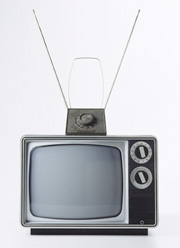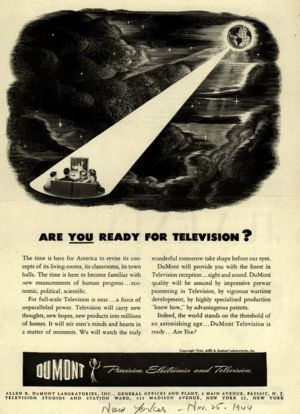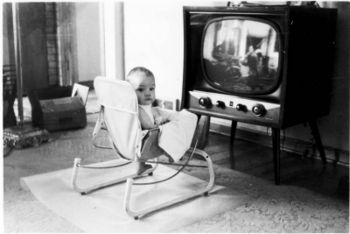Television
This article discusses the history of television programming and content, and its social and economic impact; for an account of the history of Television technology, see History of television.
Television (also, informally, "TV" and "telly") is the electronic transmission of moving pictures. The word "television" literally means "far sight"; it was formed by combining the Greek word τῆλε ("tele", or "far") with the Latin word visio-n ("sight", from video, vis- to see) — this coinage follows the pattern of telegraph ("far writer") and telephone ("far talker"). A parallel constuction may be found in German, where it is known as "fernsehen" or "far-seer." In general usage, the meaning of "television" has been expanded to also refer to receivers, and to video in conventional broadcast as well as cable and satellite signals.The word is also used to describe, in broad terms, the content of television programming generally; that is how it is used here.
Content of television programming
The content of television has evolved considerably since the earliest broadcasts in the late 1920's in Britain. The evolution of the medium can best be understood by looking at the broad historical trends, which themselves were often driven by technical innovations, such as higher definition signals, color, and an increased number of available channels and networks.
Earliest broadcasts: 1929-1935
In its earliest days, there was a good deal of incertainty as to what exactly what sort of material was suitable for broadcasts. The BBC's earliest broadcasts using the Baird system tended to focus on music-hall performers, singers, and novelty acts. A typical daily program, from the week of December 4th 1930, included the folowing:
- Bernard Dudley - character vocalist
- Pauline & Diana - instrumental entertainment
- Keith Mason - and his ukelele
- Eric Mason - entertainer and conjurer
- Gaye Jukes - musical comedy artists
- "Coal comfort" - a sketch by L. Saxey
- Jack Royce - coon songs
As the earliest regularly scheduled broadcasts of television in the world, this Baird programming is quite remarkable. Most of the acts performed for only a few minutes each, as the BBC had only allocated a half-hour at morning and at night. There are, in fact, surviving home recordings of these broadcasts; using a "Silvatone" home-recording deck, a viewer in 1933 had recorded a number of snippets of the BBC signal, including a segment featuring the "Paramount Astoria Girls," a popular dance troupe of the day. These recordings have been restored by Scottish engineer Donald McLean, and give a unique window into early television, as they are the first recordings ever made of broadcast television.[2] It is remarkable what the producers were able to accomplish with their heavy, fixed camera and sharply limited camera angle; the full recording shows faces popping out from behind a curtain, followed by the entry of the dancing girls, over which the camera was slowly panned (the only motion then possible; see image at left). Due to the fact that the Silvatone disc could record only one channel, there is no sound. In addition to live programming, cinema films were regularly shown, as Baird's had developed an early mechanical-scanning telecine process in 1929.
The BBC, in anticipation of a new higher-definition system, ended regularly scheduled 30-line transmissions in 1934.
BBC High Definition, 1936-1939

On November 2, 1936, the BBC launched its new higher-definition broadcasts from new studios at Alexandra Palace. Originally, broadcasts alternated between the Baird process, which used cinema cameras and "intermediate film" processing which scanned freshly-developed film while still wet, and the all-electronic EMI-Marconi system, which used the Emitron tube (both were received electronically and displayed on Cathode-Ray tubes). Both processes suffered from some technical problems at the start, but the BBC eventually decided in favor of the EMI system; all broadcasts using Baird's system ceased early in 1937. The broadcasts were made from specially-designed studios at Alexandra Palace, and employed a new higher-definition 405-line broadcast standard as called for in the report of the Selsdon Committe to the BBC. The first announcers were Leslie Mitchell, Elizabeth Cowell, and Jasmine Bligh, and the first hour's program (repeated via both the Baird and the EMI systems) was as follows:
- 3.00 pm Opening of the BBC Television Service by GC Tryon (Postmaster General), Mr RC Norman (chairman of the BBC), and Lord Selsdon (chairman of the Television Committee).
- 3.15 Interval; Time, Weather
- 3.20 British Movietone News
- 3.30 Variety Adele Dixon (musical comedy star), Buck and Bubbles (comedians and dancers), The Lai Founs (Chinese jugglers) and the BBC Television Orchestra
- 4.00 Closedown; a chart arranged in co-operation with the Air Ministry will forecast the weather
The BBC television service was abruptly suspended on the eve of Word War II.
The post-WWII era: 1945-1960
Both the UK and the US limited television broadcasting during the wartime years. In the UK, broadcasts were stopped entirely, while in the US, though limited broadcasts continued, no new television receivers could be manufactured or sold. The immediate post-war period was a heady one in both countries, though US growth was to be the fastest. The UK continued its pre-war model of using licensing fees for recreivers, such that the BBC transmissions had no commercial content, whereas in the US, the sponsorship model used for radio quickly became the standard for television as well.
One early pioneer was the DuMont Network, a subsidiary of DuMont Television Laboratories, an early television manufacturer, which launched in 1946 as the first television-only network. In radio, most shows had had sole sponsors, who as a result exercised enormous control over content; DuMont was a pioneer of the model in which each individual program had multiple sponsors, freeing the producers of its shows from the veto of a single sponsor. A characteristic array of DuMont programming included stage entertainers, news, variety shows, televised films, and genre dramas; the following is a characteristic sample (dates of broadcast in parentheses)
- The Adventures of Ellery Queen (1951)
- The Author Meets the Critics (1952-1954)
- Camera Headlines (news) (1948)
- Cavalcade of Stars (variety) (1949-1952) (The Honeymooners had its debut as a skit on this show)
- Frontier Theatre, (movies) (1950)
- Morey Amsterdam Show (variety) (1949-1950)
- On Your Way (game show) (1953-1954)
- Opera Cameos (music) (1953-1955)
- The Roy Doty Show (children) (1953)
- TV Shopper (shopping) (1948-1950)
- Twenty Questions (game show) (1951-1954)
- Washington Report (1951) (public affairs)
The"boomer" generation: 1960-1985
The period from 1960 to 1985 saw the greatest increase in television viewership, the greatest increase in televisions per home, and the greatest increase in average weekly hours viewed, in the entire history of television to date. This was in part because of the Baby boom generation, born between 1945 and 1962, which made a significant demographic spike as it aged. During this period, broadcast television in the United States was dominated by three large networks: ABC, NBC, and CBS. At the same time, the introduction of UHF frequencies added a new venue for smaller, independent television stations.
With the collapse of the DuMont network in 1959, its three main affiliates were absorbed into ABC, which remained the smallest of the three networks througout most of this period. CBS, which had already built a large radio network, quickly became the dominant player in the market. At the same time, NBC, particularly through its promulgation of the first widely-successful color television technology, became a major force. By the late 1960's, in most major U.S. markets, each of the three networks had a local affliate broadcasting on the VHF bandwidth; as UHF gradually expanded, the kinds of low-budget independent shows which had earlier dominated VHF stations moved to UHF.
Network "affiliates," agreed to broadcast the network's programs during the "prime time" hours or 8 to 11 p.m. weeknights; in return, they obtained both a share of national advertising revenue, as well as a smaller bloc of time allocated to their local advertisers. As a result, the shows produced by the three major networks captured an unprecedented share of the nationwide television audience, and as this share grew, so did advertising revenue.
Cable television
The post-broadcast era: digital signals and HDTV, 2006-?
Social impact of television
References
- ↑ Clip of 1933 recording. Used with permission of Donald McLean from his tvdawn.com website.
- ↑ See Donald McLean's tvdawn.com page for details on "The Earliest Known Recording of Broadcast Television."


